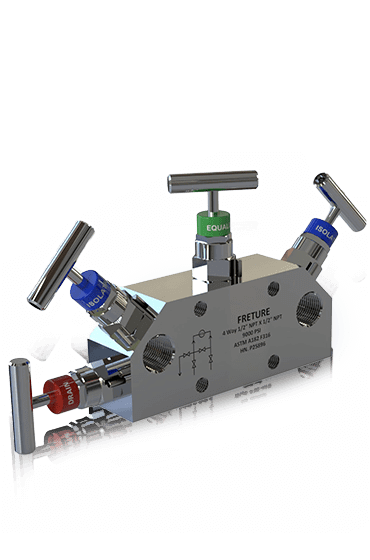A 3 way manifold is a vital component used in fluid control systems to distribute or combine fluids from multiple sources. It typically consists of three ports that allow the flow of fluids in various configurations.
3 Way Manifold Valves
The 3 Way Valves Manifold is used to ensure that the capsule is not over-ranged.
Freture Techno, a leading 3 Way Manifold Valves manufacturer in Mumbai, India, essential components in fluid control systems. 3 way manifold Valve is designed to facilitate versatile fluid distribution, enabling the diversion, combination, or isolation of fluid flow from one inlet to two outlets or vice versa. 3 Way Manifold used in variance pressure request with Pressure gauges, Pressure switches & pressure transmitters
Crafted with precision, 3 Way Manifold features robust construction, ensuring durability and reliability in various industrial applications. It is constructed using high-grade materials such as stainless steel, brass, or carbon steel, offering excellent corrosion resistance and compatibility with diverse fluids and operating conditions.
Widely used in industries such as oil and gas, chemical processing, water treatment, pharmaceuticals, and food and beverage, our 3 Way Manifold Valve ensures efficient fluid control, precise pressure measurement, fluid mixing, level monitoring, and process control.
Choose Freture Techno for your 3 Way Manifold for pressure gauge needs, and experience unmatched quality, reliability, and exceptional customer service.

Description | Features |
|---|---|
TYPE: 3 valve (S / T / H /Coplanar) Manifold End Connection: Flange / Butt Weld Size: 15 NB - 300 NB Pressure Rating: 150PSI to 6,000PSI Temperature Range: -7Deg C to 280 Deg C Body Materials: Stainless Steel / Carbon Steel / Alloys Design Standard: ISO 17292 rev 2004, B16.5 Face to Face: ASME B16.10 Rev 2009 Safety: NACE MOR 0175 , BS/EN 10204-3.1 REV 2004, API 598 Rev 2009, API-607 |
|
Related Products
FAQ’s
Have a question before you buy our products? Take a look at the FAQs below.
If you don’t find the answer you’re looking for, get in touch with us here.
- What is a 3-way Manifold?
- How does it work?
A 3 way manifold functions by directing the flow of fluids from one inlet to two outlets, or from two inlets to one outlet, depending on the specific configuration. This enables the user to control the flow direction and distribution according to the application requirements.
- What are the main applications?
3 way manifolds find widespread applications in industries such as oil and gas, chemical processing, water treatment, and pharmaceuticals. Manifold Valves are commonly used in flow control systems, pressure measurement, level monitoring, and fluid distribution processes.
- What are the benefits of using one?
The benefits of using a 3-way manifold include versatility in fluid control, compact design, simplified piping arrangements, enhanced system efficiency, and improved control over fluid distribution. They also enable easier maintenance and troubleshooting of fluid systems.
- What materials are used in their construction?
3-way manifolds are typically constructed from materials such as stainless steel, brass, or carbon steel, depending on the specific application requirements. These materials are chosen for their durability, corrosion resistance, and compatibility with various fluids and operating conditions.
- How do I choose the right one for my application?
Choosing the right 3-way manifold involves considering factors such as the type of fluid, pressure and temperature requirements, flow rates, compatibility with existing systems, and environmental conditions. Our technical experts can assist in selecting the most suitable manifold for your specific application needs.
- Can they be repaired?
Yes, 3-way manifolds can often be repaired. Maintenance and repair may involve replacing worn components, such as seals or valves, and ensuring proper calibration to restore functionality.
- What maintenance is required?
Regular maintenance of 3-way manifolds typically includes inspection, cleaning, and lubrication of moving parts. It's essential to ensure proper functioning and extend the lifespan of the manifold.
- Are they available in different designs?
Yes, 3-way manifolds are available in various designs and configurations to suit different application requirements. These designs may include different port sizes, connection types, and valve arrangements to accommodate specific fluid control needs.
- Why is Freture the best place to buy from?
Freture is the best place to buy 3-way manifolds due to our commitment to providing high-quality products, expert technical support, competitive pricing, and exceptional customer service. Our 3-way manifolds are designed and manufactured to the highest industry standards, ensuring reliability, durability, and performance in diverse industrial applications.
Industries where 3 Way Manifold Valve is used
Chemical Manufacturing
Oil & Gas Refineries
Pharmacutical Industry
Water treatment Industry
Food & Beverage Industry
Applications of 3 Way Manifold Valves
Flow Distribution: They are used to distribute the flow of fluids from a single inlet to two separate outlets or from two inlets to a single outlet, enabling versatile fluid distribution in various industrial processes.
Pressure Measurement: They facilitate pressure measurement by allowing the connection of pressure transmitters to multiple process lines, providing accurate pressure readings for monitoring and control purposes.
Fluid Mixing: They are employed to mix fluids from different sources by combining them into a single outlet, ensuring uniform mixing and blending of fluids in chemical processing, water treatment, and other industries.
Level Monitoring: They are utilized for level monitoring in tanks and vessels by connecting level sensors to different ports of the manifold, enabling precise monitoring and control of fluid levels.
Process Control: They play a crucial role in process control systems, allowing for the diversion, isolation, or combination of fluid streams to regulate flow rates, pressure, and temperature in industrial processes.







